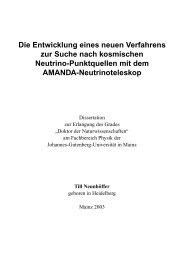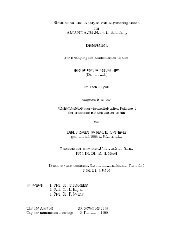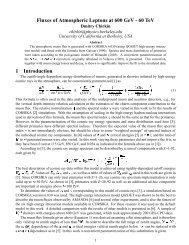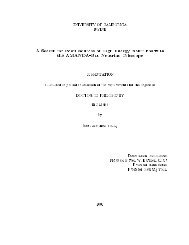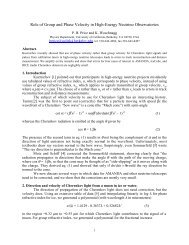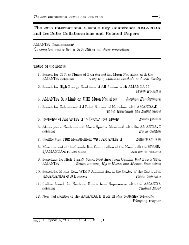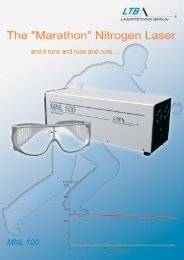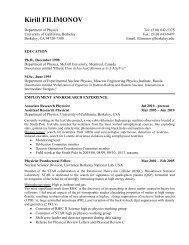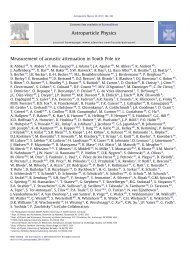Link to Fulltext
Link to Fulltext
Link to Fulltext
Create successful ePaper yourself
Turn your PDF publications into a flip-book with our unique Google optimized e-Paper software.
mation found in [10] is:<br />
¥<br />
¢ ¤ ¡ <br />
¦¡<br />
<br />
<br />
© £ ¢ £¢¥¤ ¡<br />
¢¡<br />
© £ ¢ ¢¡<br />
<br />
¦§¢¥¤ ¡<br />
©¦<br />
<br />
<br />
¢ ¤ ©¦ <br />
¢ ¤ ©¨<br />
<br />
<br />
the neutrino cross-section goes from linear <strong>to</strong> logarithmic growth in those two energy intervals<br />
(see Fig. 5) and the muon range goes from linear <strong>to</strong> constant behaviour. Then the flux of muons<br />
due <strong>to</strong> incoming neutrinos can be obtained as<br />
¢<br />
¡ <br />
<br />
¦<br />
<br />
¤ ¨¢ ¤ <br />
¥<br />
¢ ¤ ¢<br />
<br />
© ¡ © ¡ ¢ ¢ ¡ ¢ £ ¢ ¤<br />
<br />
¥¨§ ©<br />
<br />
©<br />
which is a convolution of the neutrino flux with the probability defined in Eq. 24 and an exponential<br />
term taking care of the absorption of neutrinos as they pass through the Earth. Absorption<br />
becomes important for<br />
Folding the differential flux given by Eq. 26 with the effective area in an integral over all<br />
declinations yields the expected rate of events :<br />
The Cherenkov effect<br />
¢ ¤ ¢¡ <br />
[10].<br />
¦<br />
¢<br />
¡ <br />
£ ¢ £ <br />
<br />
A high energetic muon passing through the ice will emit Cherenkov light at a fixed angle.<br />
The condition for this effect <strong>to</strong> happen is that a charged particle travels with a speed<br />
<br />
higher<br />
<br />
than<br />
the speed of light ( ¢ in the medium ), in which case it has an energy greater than the<br />
critical <br />
Cherenkov energy:<br />
(28)<br />
¢ <br />
¢ <br />
<br />
¦<br />
¡<br />
¢ <br />
<br />
¢<br />
<br />
¢ ¦ ¢ ¦<br />
<br />
<br />
where is the wavelength-dependent refractive index of the transparent material considered.<br />
In the case of AMANDA, where we use ice, (see Fig. 32) over the range of<br />
wavelength the optical modules are sensitive <strong>to</strong> (between 300 and 600 nm) and if the particle<br />
under consideration is a muon, this yields a critical energy in ice of 160 MeV. The Cherenkov<br />
angle relative <strong>to</strong> the velocity of the particle at which the pho<strong>to</strong>ns are emitted is then given by<br />
which is simply ¢ <br />
when , ¦<br />
¢ yielding<br />
is just a cone with an opening half-angle of as shown in Fig. 8.<br />
The energy lost in emitted light per unit length and unit frequency is:<br />
¢ £<br />
£ ¦ £§<br />
§<br />
<br />
<br />
<br />
<br />
<br />
<br />
¦<br />
16<br />
(25)<br />
(26)<br />
(27)<br />
¢ (29)<br />
<br />
<br />
, in which case the Cherenkov wavefront<br />
<br />
<br />
<br />
(30)<br />
<br />
¢ <br />
with being the fine structure constant, <br />
¤ . In our case, with a limited optical window<br />
¦<br />
due <strong>to</strong> the sensitivity of the PM and <strong>to</strong> the filtering power of the glass-sphere enclosing it, the



